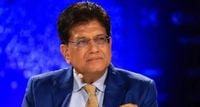In a week marked by high-stakes diplomacy and shifting alliances, India’s global trade and foreign policy strategies are under the spotlight as the country navigates complex negotiations with ASEAN, the European Union, and the United States. On October 26, 2025, Malaysian Prime Minister Anwar Ibrahim announced that "some real progress" had been made in the ongoing review of the trade agreement between India and ASEAN, following a summit in Kuala Lumpur. Indian Prime Minister Narendra Modi addressed the gathering virtually, underscoring the importance of the partnership but also hinting at the challenges ahead as the year-end deadline for a revamped deal looms.
Meanwhile, India’s Commerce and Industry Minister, Piyush Goyal, is set to travel to Brussels on October 27 and 28, 2025, to advance negotiations on the proposed India-EU Free Trade Agreement (FTA). According to the Indian Ministry of Commerce, Goyal’s visit is intended to "provide strategic direction and political impetus" to the talks, which have entered their final stages. The ministry’s statement highlighted that both sides are intensifying efforts to conclude a "comprehensive, balanced, and mutually beneficial trade agreement at the earliest."
The India-EU FTA has been years in the making, with negotiations resuming in June 2022 after an eight-year hiatus triggered by disagreements over market access and regulatory issues. The 14th round of talks, held from October 6 to 10, 2025, saw both parties reviewing progress and pinpointing areas where further convergence is needed. Goyal’s upcoming discussions with Maros Sefcovic, Executive Vice-President and European Commissioner for Trade, are expected to cover critical issues such as market access, non-tariff measures, and regulatory cooperation. The negotiations span 23 policy areas, including trade in goods and services, investment, intellectual property rights, sustainable development, and government procurement.
India’s economic ties with the EU are substantial. In 2024-25, bilateral trade in goods reached USD 136.53 billion, with Indian exports accounting for USD 75.85 billion and imports from the EU totaling USD 60.68 billion. The EU represents approximately 17% of India’s total exports, making it the country’s largest trading partner for goods. Indian exports to the bloc—ranging from readymade garments and pharmaceuticals to steel, petroleum products, and electrical machinery—stand to become even more competitive if the FTA is finalized. The EU, for its part, is seeking significant tariff reductions on automobiles, medical devices, wine, spirits, meat, and poultry, as well as a stronger intellectual property regime.
While India pushes forward on multiple trade fronts, its relationship with the United States is facing unprecedented strain. On October 15, 2025, President Trump declared that India would stop importing Russian oil—a move he described as a "big step" toward pressuring Russia to end its war with Ukraine. However, Indian officials quickly refuted this, clarifying that "there was no telephonic conversation between the PM Modi and US President Trump," casting doubt on Trump’s assertion. The Indian Ministry of External Affairs emphasized the country’s commitment to "safeguard interests...in a volatile energy scenario," signaling a determination to maintain autonomy in its energy policy.
The backdrop to these tensions is the imposition of 50% tariffs on Indian goods by the Trump administration in August 2025—the highest of Trump’s term. Notably, these tariffs did not extend to other major importers of Russian oil such as China or Turkey. Russia currently supplies about one third of India’s oil imports, totaling 1.62 million barrels per day in September 2025. Modi has consistently pushed back against U.S. pressure, insisting that India will continue to pursue the "best deal" to protect its 1.4 billion citizens.
The rift between the U.S. and India is particularly striking given the three-decade history of a strategic partnership centered on defense, technology, and Indo-Pacific security. In April 2025, U.S. Vice President Vance described the relationship as "the cornerstone of global progress," warning that world order could be threatened if the two nations failed to cooperate. However, a series of recent disagreements—including Trump’s claim that he brokered a ceasefire between India and Pakistan in May 2025, Modi’s refusal to nominate Trump for the Nobel Peace Prize, and ongoing disputes over energy and trade—have eroded trust on both sides.
Senior analysts warn that these developments could "threaten the long-term foundation" of the U.S.-India partnership, with Damian Murphy of the Centre of American Progress noting that the damage "may prove impossible to repair." The appointment of a new Indian ambassador, Sergio Gor, and his subsequent meeting with Modi to discuss defense, trade, and technology were initially seen as a positive sign. Yet, India’s approach remains steadfastly "deliberate," with officials signaling that while adjustments to oil imports may occur, they will not publicly yield to U.S. demands. As former Indian ambassador to the United Nations, Syed Akbaruddin, put it: "cooperation yes, coercion, no."
India’s strategy of "political non-monogamy"—maintaining strong ties with both Russia and the U.S.—dates back to its independence in 1947 and has been shaped by decades of diplomatic, economic, and military engagement with both superpowers. Despite deepening defense agreements with Washington, India continues to engage in two-way supply of military hardware and technology with Moscow. This balancing act is becoming increasingly difficult as the U.S. steps up direct sanctions against Russia’s largest oil firms, prompting Indian energy organizations to "recalibrate" their purchases.
The pressure on India to "pick a side" is mounting amid global polarization, but the Modi government has made it clear that strategic autonomy remains a top priority. As the country juggles high-profile trade negotiations with ASEAN and the EU, while fending off U.S. demands and sanctions, its choices in the coming months will have far-reaching implications—not just for its own economic and security interests, but for the broader balance of power in the Indo-Pacific and beyond.
For now, India’s diplomatic dance continues. With critical trade talks underway in Brussels and Kuala Lumpur, and with Washington’s demands growing louder, New Delhi faces a defining moment in its foreign policy. The world is watching to see whether India can maintain its delicate balancing act—or if shifting global tides will force its hand.

